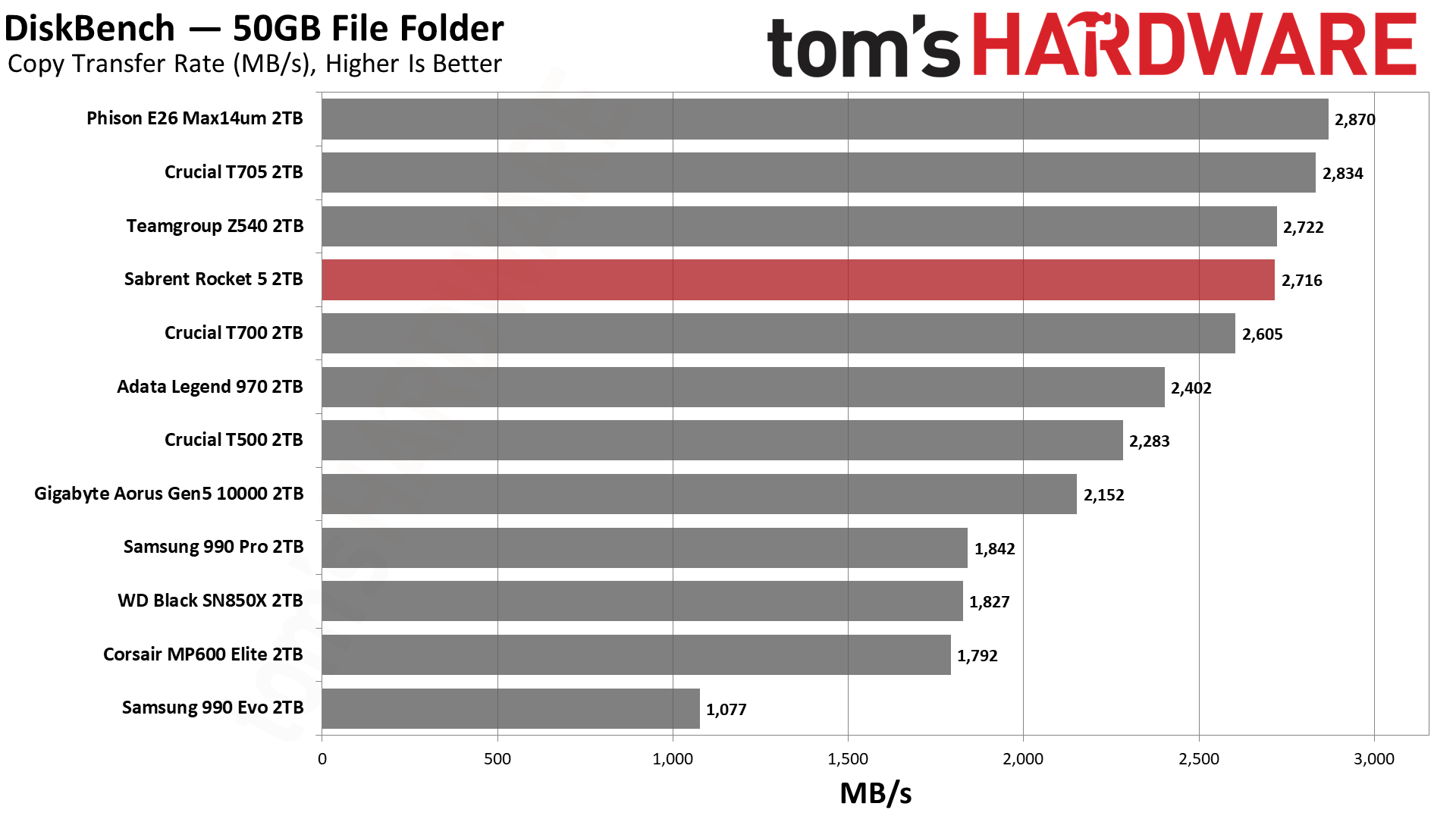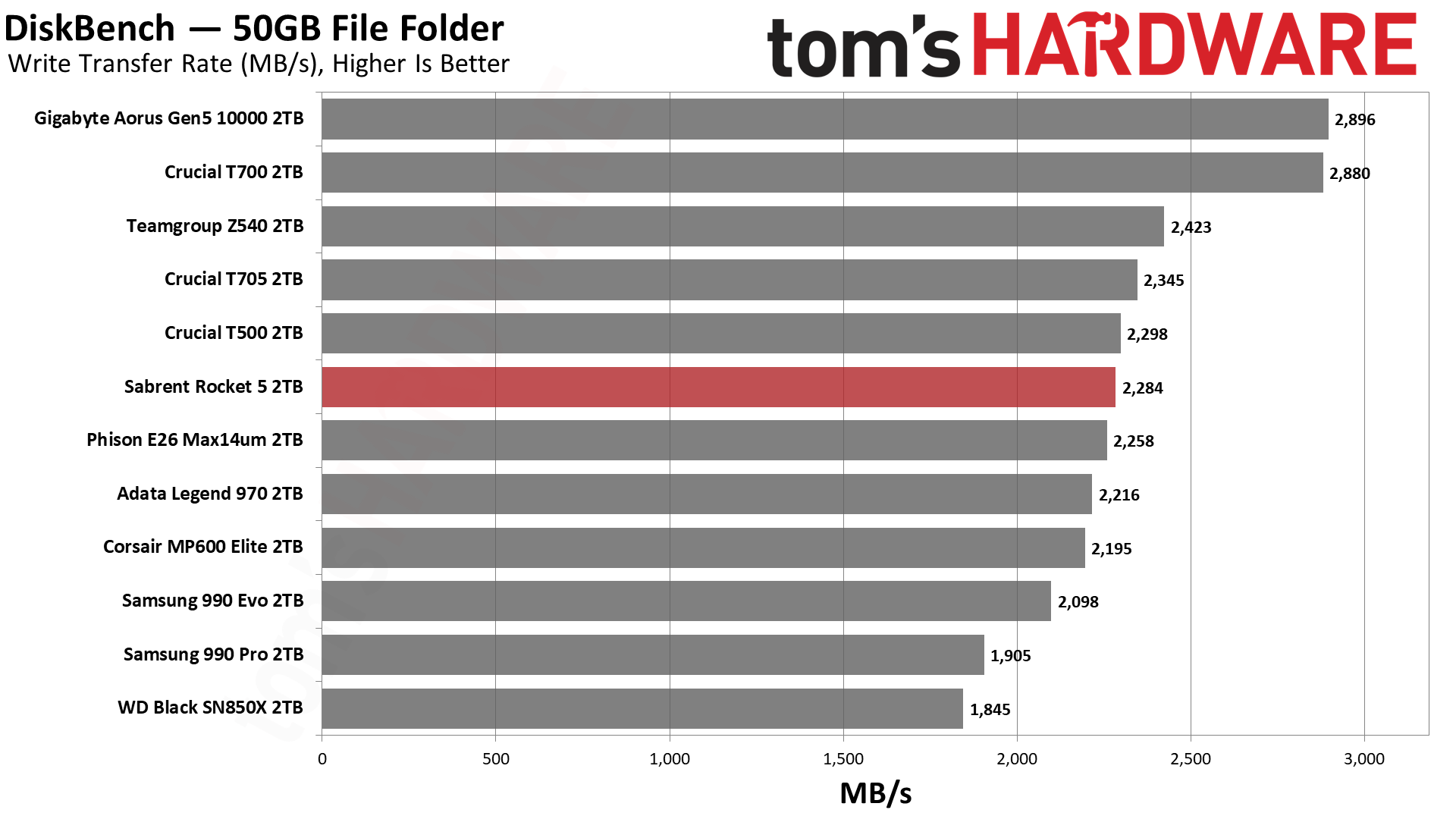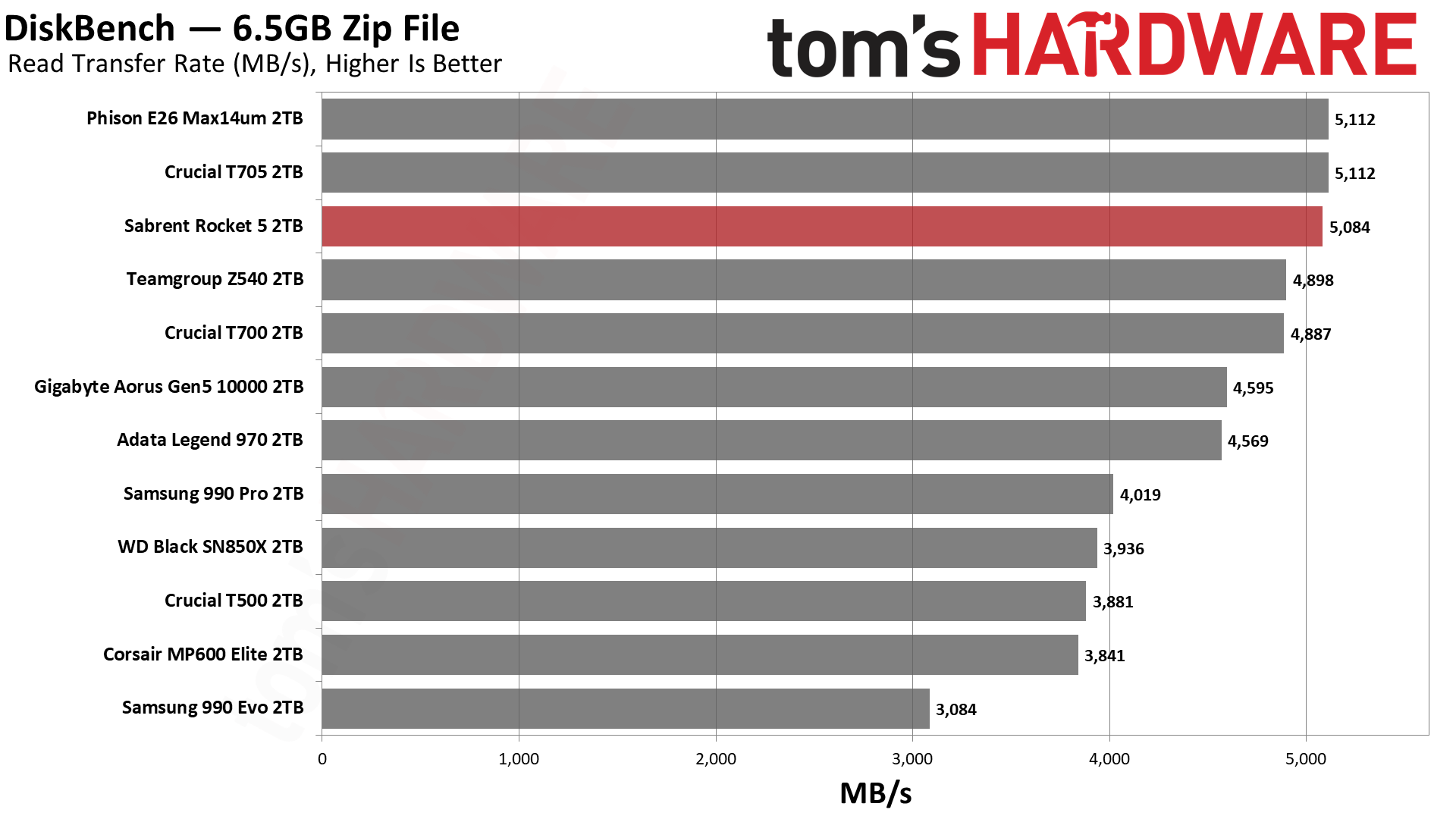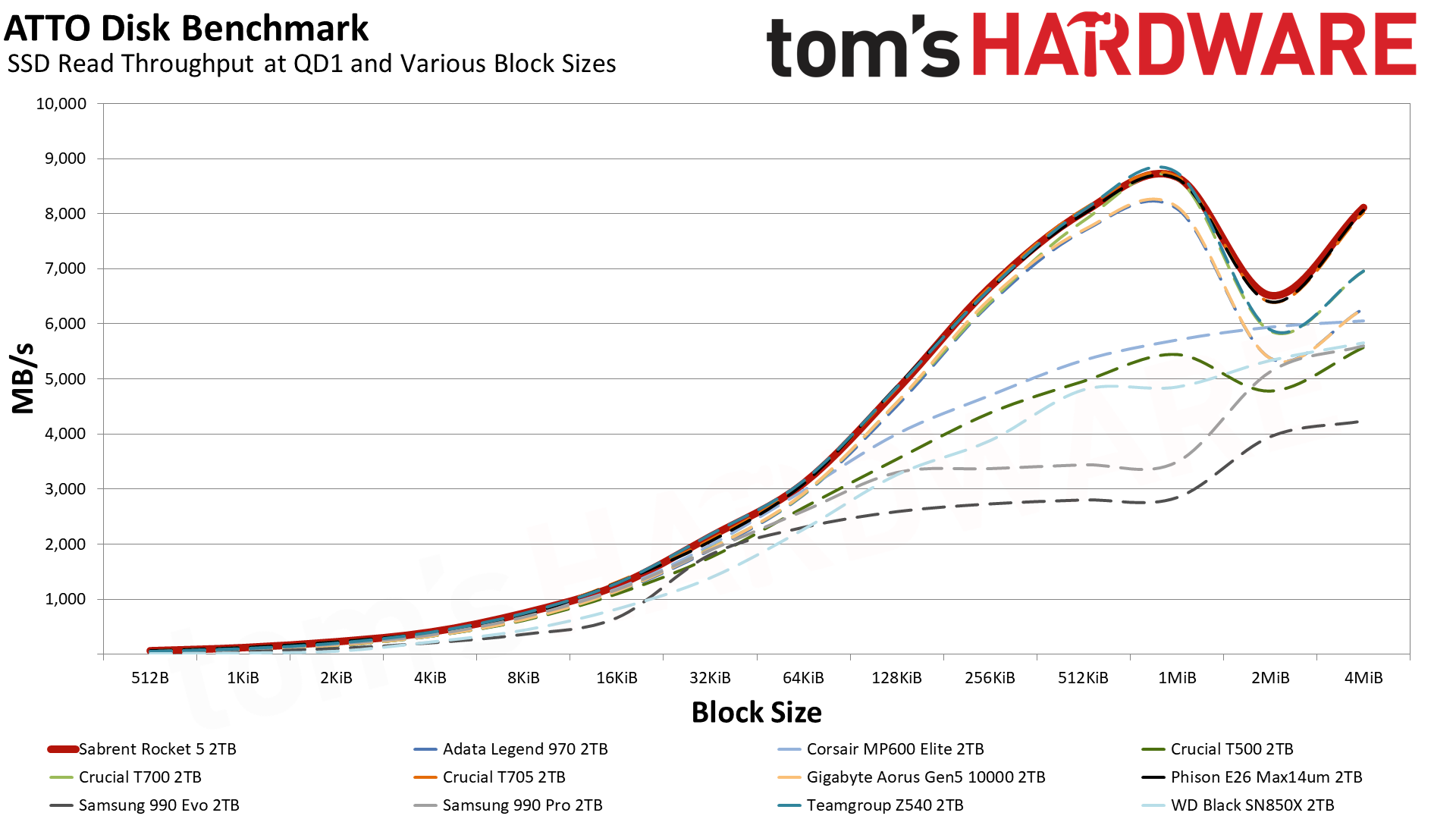Why you can trust Tom’s HardwareOur expert reviewers spend hours testing and comparing products and services so you can choose the best for you.Find out more about how we test.
Sabrent Rocket 5 2TB Performance Results
Comparison Products
Today we have some serious contenders going up against the Rocket 5, including Phison’sMax14umreference design as well as other fast drives like theCrucial T705andTeamgroup Cardez Z540. Slower PCIe 5.0 SSDs are also included with theCrucial T700,Gigabyte Aorus Gen5 10000, andAdata Legend 970. TheSamsung 990 EVOis also technically a PCIe 5.0 drive, but it only runs with two lanes in that mode.High-end PCIe 4.0 SSDs include theSamsung 990 Proand theWD Black SN850X. So-called “budget” 4.0 drives can often rival high-end alternatives, and the best two we have on hand are theCrucial T500andCorsair MP600 Elite.
Trace Testing — 3DMark Storage Benchmark
Built for gamers, 3DMark’s Storage Benchmark focuses on real-world gaming performance. Each round in this benchmark stresses storage based on gaming activities including loading games, saving progress, installing game files, and recording gameplay video streams. Future gaming benchmarks will be DirectStorage-inclusive and we include details of that where possible.
The Rocket 5 scores well in 3DMark, above the Z540 but below the T705. It’s pretty close to the expectation from the Max14um preview. This is a high performance drive, perhaps overkill for games but undeniably fast. Its latency is quite good, which can correlate with game load times.Like the other E26-based drives, the Rocket 5 does have DirectStorage-optimized firmware. There aren’t too many games that support DirectStorage yet, with the most recent beingHorizon Forbidden West. That title doesn’t leverage the full feature set, but load times are somewhat improved with the technology.
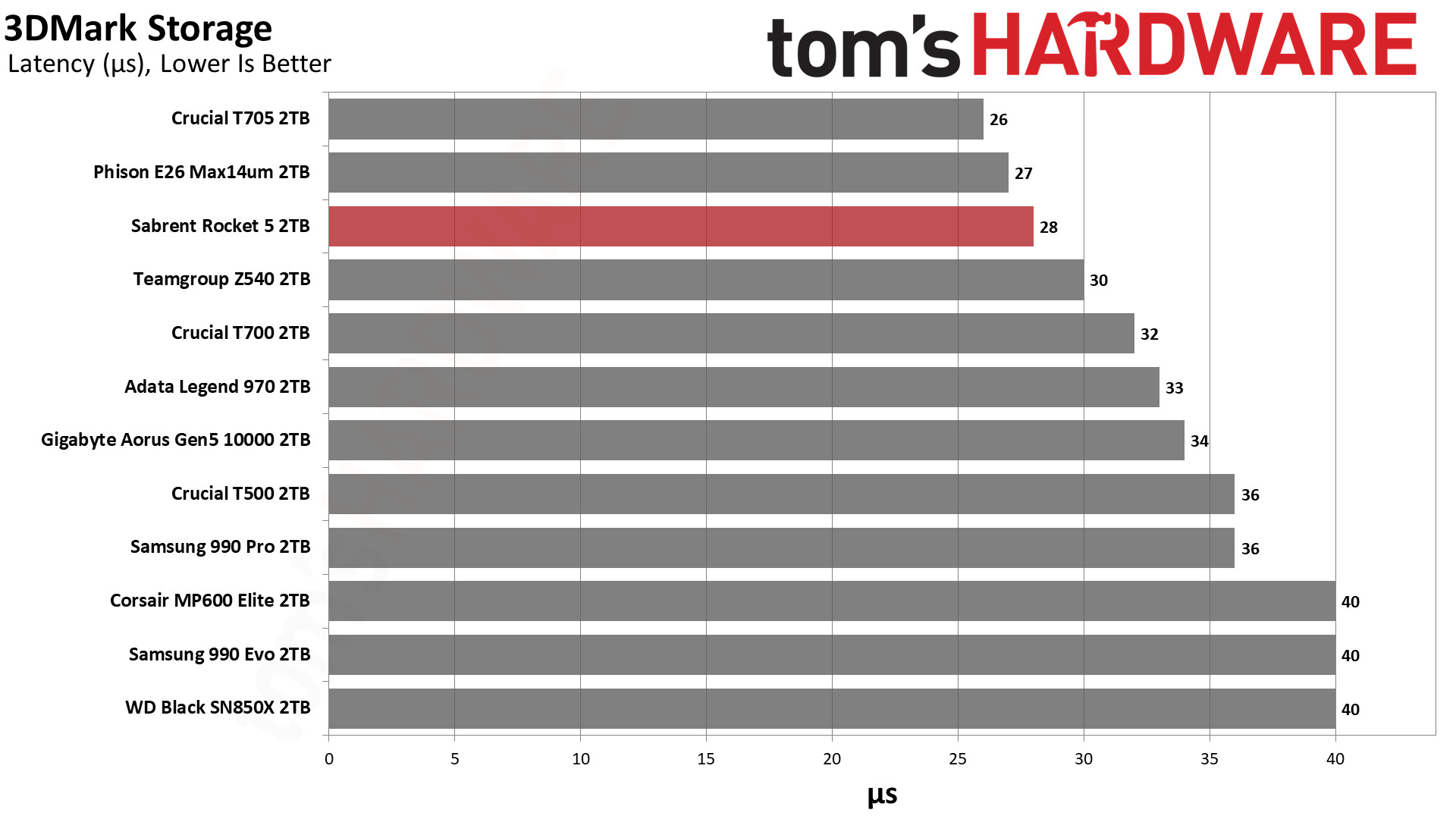
Trace Testing — PCMark 10 Storage Benchmark
PCMark 10 is a trace-based benchmark that uses a wide-ranging set of real-world traces from popular applications and everyday tasks to measure the performance of storage devices.
PCMark 10 performance is also as expected, with the Rocket 5 beating all PCIe 4.0 SSDs as well as the lower-end 5.0 drives. Its performance is close to the reference Max14um. This drive should provide excellent application performance.
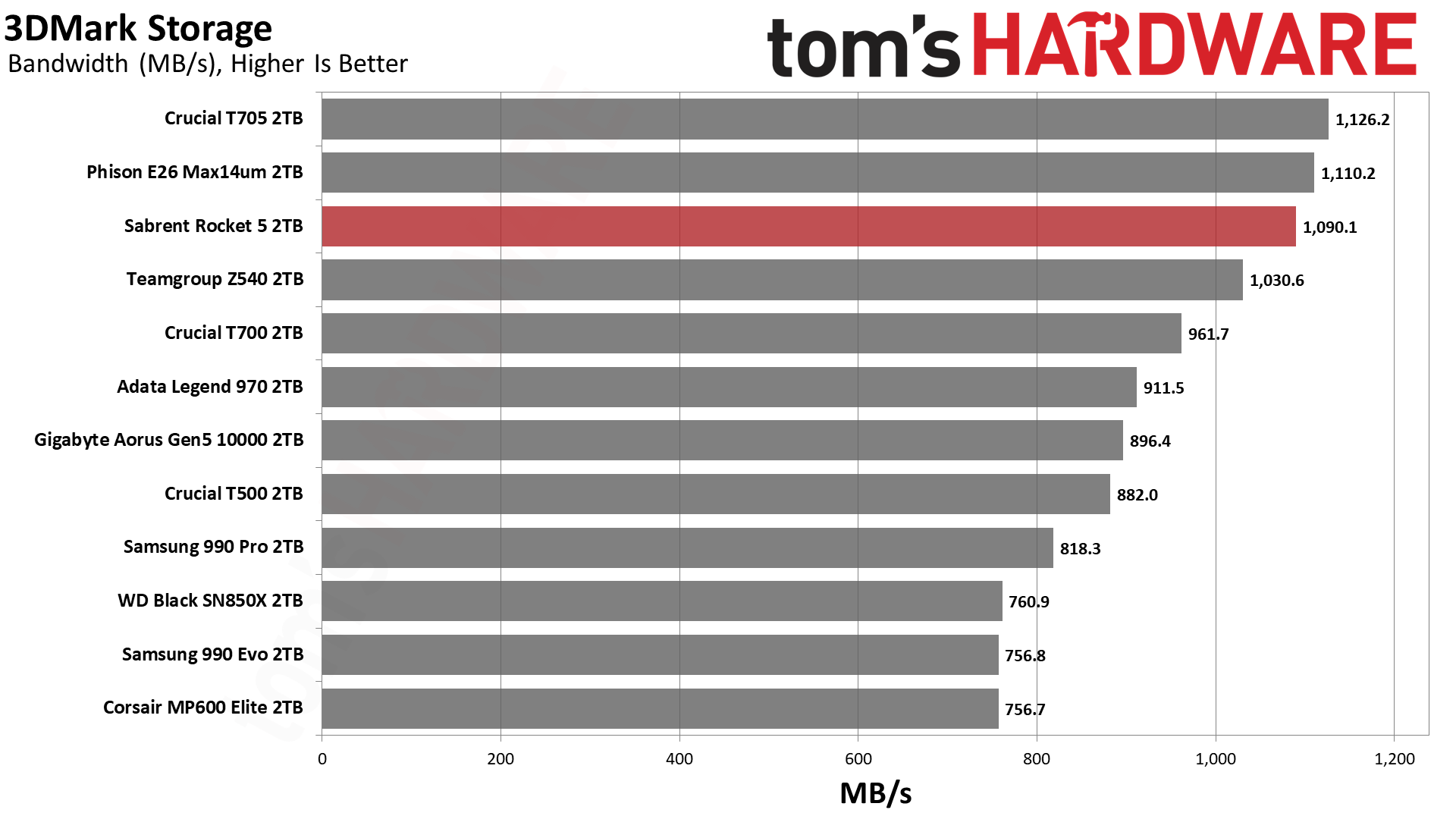
Transfer Rates – DiskBench
We use the DiskBench storage benchmarking tool to test file transfer performance with a custom, 50GB dataset. We write 31,227 files of various types, such as pictures, PDFs, and videos to the test drive, then make a copy of that data to a new folder, and follow up with a reading test of a newly-written 6.5GB zip file. This is a real world type workload that fits into the cache of most drives.
DiskBench copy performance is quite good, but not the best. This is likely due to the lower write performance. To fully gauge this it’s best to also look at our ATTO, CrystalDiskMark, and sustained write tests. Together they can paint a better picture of what to expect in different writing scenarios.
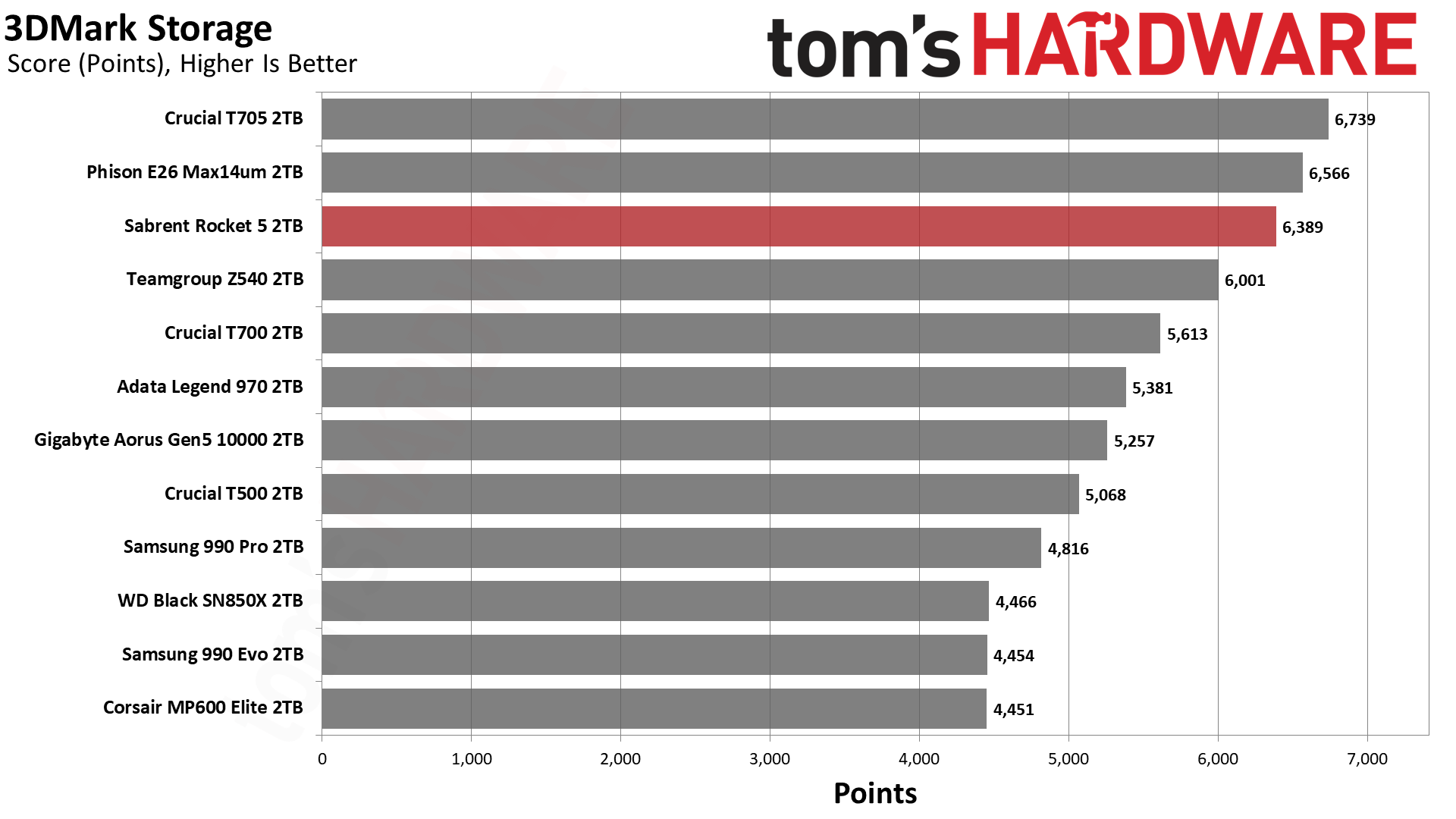
Synthetic Testing — ATTO / CrystalDiskMark
ATTO and CrystalDiskMark (CDM) are free and easy-to-use storage benchmarking tools that SSD vendors commonly use to assign performance specifications to their products. Both of these tools give us insight into how each device handles different file sizes and at different queue depths.
ATTO performance is bang-on, which is to say exemplary. The Rocket 5 can read and write very quickly, particularly at higher block sizes. The E26 controller does, however, score lower for writes at sub-4KiB block sizes. This is possibly due to its enterprise origins and, luckily, does not seem to impact real world performance. 4KiB performance in general is indicative of feel, and the Rocket 5 is good there.This is reflected in CDM, where the Rocket 5 has excellent 4KB random read latency and strong 4KB random write latency. The initial version of the Samsung 990 Pro is still on top for the former, but the fastest PCIe 5.0 SSDs — like the Rocket 5 — give it a run for its money. Write latency is often less important for real world feel, but the Rocket 5 scores as expected and not poorly. Sequential performance is excellent as well, the fastest you can get from any current drive on the market.
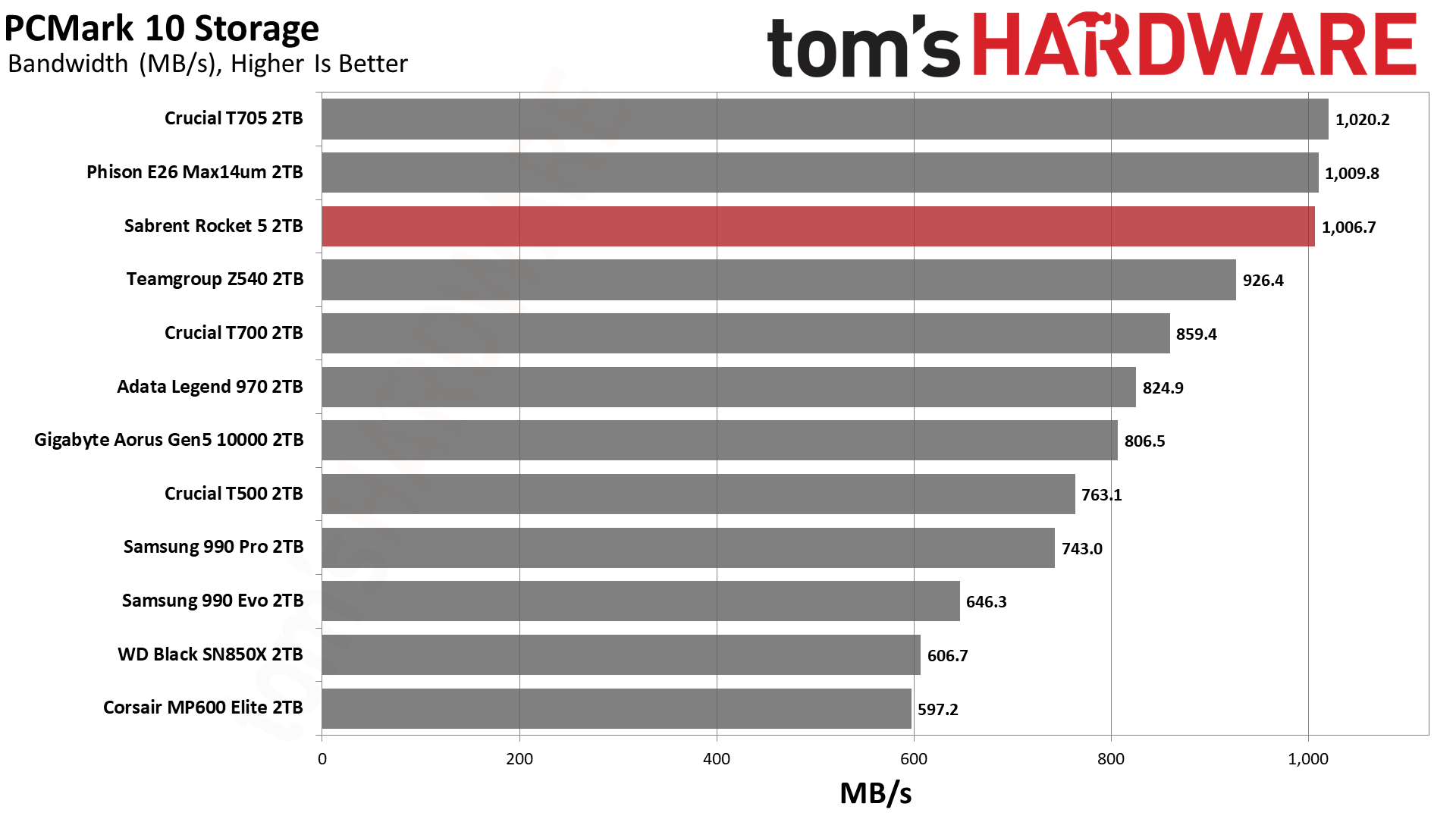
Sustained Write Performance and Cache Recovery
Official write specifications are only part of the performance picture. Most SSDs implement a write cache, which is a fast area of (usually) pseudo-SLC programmed flash that absorbs incoming data. Sustained write speeds can suffer tremendously once the workload spills outside of the cache and into the “native” TLC or QLC flash.We use Iometer to hammer the SSD with sequential writes for over 15 minutes to measure both the size of the write cache and performance after the cache is saturated. We also monitor cache recovery via multiple idle rounds. This process shows the performance of the drive in various states as well as the steady state write performance.
The 2TB Rocket 5 writes in pSLC mode at 12.4 GB/s for 18 seconds with a 210GB cache. This is much smaller than what is possible, but it’s large enough to ensure peak write performance in the most common tasks.After the cache is exhausted, the drive writes directly to the TLC flash at up to 4.5 GB/s with steady state performance pegged at 4.45 GB/s. This is an excellent result, and in fact it’s the fastest drive we’ve ever tested. Sabrent may have introduced some firmware optimizations to get the most out of this flash.Although the drive is capable of emptying the pSLC cache in the background, host I/O is given priority and eventually the lack of free native TLC flash space catches up to it. After this, the drive enters a folding state where it writes at 1.7 GB/s. This is still pretty fast. Folding performance is usually less than half of the direct-to-TLC speed as the drive is forced to wait as data is transferred from pSLC to TLC, which consists of already-written data needing an extra pSLC write and read in comparison. This lines up pretty well with our results.The takeaway here is that the Rocket 5 reaches all new heights in terms of TLC flash sustained write performance, helping it stand out from other drives in the pack. If that’s something that interests you, this drive should be on the top of your list.

Power Consumption and Temperature
We use the Quarch HD Programmable Power Module to gain a deeper understanding of power characteristics. Idle power consumption is an important aspect to consider, especially if you’re looking for a laptop upgrade, but PCIe 5.0 drives like the Rocket 5 aren’t a good fit for laptops. Desktops may be more performance-oriented with less support for power-saving features, so we show the worst-case results.Some SSDs can consume watts of power at idle while better-suited ones sip just milliwatts. Average workload power consumption and max consumption are two other aspects of power consumption but performance-per-watt, or efficiency, is more important. A drive might consume more power during any given workload, but accomplishing a task faster allows the drive to drop into an idle state more quickly, ultimately saving energy.For temperature recording we currently poll the drive’s primary composite sensor during testing with a 21-22°C ambient. Our testing is rigorous enough to heat the drive to a realistic ceiling temperature.
If there’s a place where PCIe 5.0 SSDs stumble, it’s power management. Maximum power consumption and idle power consumption are both high on E26-based SSDs, and overall power efficiency is also so-so at best. The Rocket 5 falls somewhere in the middle of its direct peers, not standing out in any way. These drives are designed for high-end desktops, and it shows.These drives also put out a decent amount of heat, so it becomes important to dissipate that heat to avoid throttling of the drive. We are not running the Rocket 5 bare or as-is, but with a passive heatsink with sufficient airflow. In our sustained write testing the Rocket 5 hit a peak of 71°C, which is significantly below the first throttling point. With appropriate cooling, this drive should have no trouble even in a higher ambient. While Sabrent does not offer a heatsink version of the drive, it does sell incredibly effective M.2 heatsinks that would make a good pairing.
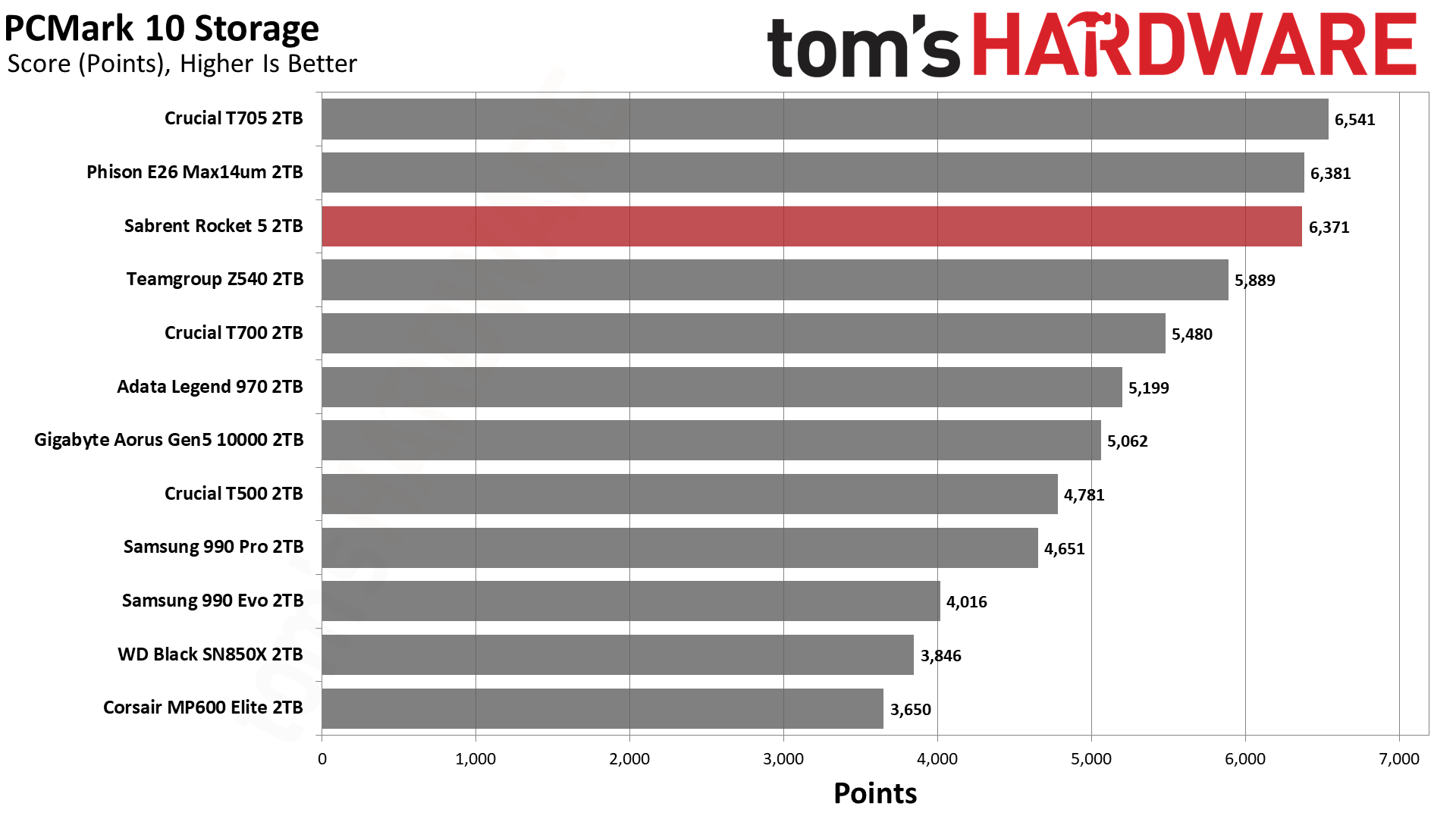
Test Bench and Testing Notes
We use an Alder Lake platform with most background applications such as indexing, Windows updates, and anti-virus disabled in the OS to reduce run-to-run variability. Each SSD is prefilled to 50% capacity and tested as a secondary device. Unless noted, we use active cooling for all SSDs.
Sabrent Rocket 5 Bottom Line
The Sabrent Rocket 5 performed admirably in our tests, usually getting close to the ultra-fast Crucial T705. It then distanced itself from the pack as the fastest drive we’ve ever tested with sustained writes. That’s arguably a niche workload, but these are high-end PCIe 5.0 SSDs we’re talking about. If you’re gunning for very high steady state write performance, the Rocket 5 is the fastest drive available on the market. It still pulls a lot of power and needs a heatsink to dissipate its heat during sustained workloads, but it otherwise hits all the right notes.The Rocket 5 also comes in the full capacity range, where 4TB is missing from some other drives in this class. Furthermore, while it seems 8TB would be a difficult hill to climb with this hardware given Phison’s tough work on the Max14um reference design, Sabrent has made it a point in the past to push for higher capacities. It’s possible or even likely that 8TB is a real goal.Some may find it disappointing that the Rocket 5 does not come with a heatsink. However, it’s convenient if you have a high-end motherboard with M.2 cooling, and Sabrent also sells its own high-end heatsinks that would make for a good bundle.Is the Sabrent Rocket 5 the right drive for you? If you want the fastest drive around, and especially if you like the sustained writes results for this drive, it could be beneficial for your workflow. We like the 2TB model in particular, though we do hope Sabrent offers 8TB later and that the 4TB price comes down.If you don’t need to be cutting-edge, there are many great PCIe 4.0 SSDs available that are far less expensive. We still recommend the Samsung 990 Pro, WD Black SN850X, Crucial T500, Corsair MP600 Elite, Lexar NM790, and other drives that share similar hardware. As time goes on, lower-end 4.0 drives and 3.0 drives in general have become less appealing, but it might be a while longer before more affordable PCIe 5.0 SSDs make their way to market.For those who want the very fastest SSD available today, the Rocket 5 does not disappoint. It’s a slightly different take on the Max14um reference design, focusing on sustained writes more than other areas, but it’s never far from the pole position. Right now, it and the Cruciat T705 are the fastest drives we’ve tested.
MORE:Best SSD for the Steam Deck
Current page:Sabrent Rocket 5 2TB Performance Results
Shane Downing is a Freelance Reviewer for Tom’s Hardware US, covering consumer storage hardware.
